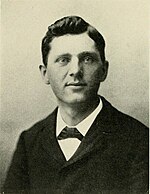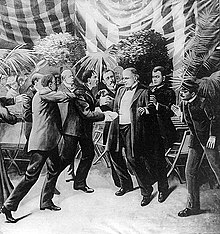Leon Czolgosz
Leon Frank Czolgosz | |
|---|---|
 Photo from 1900, found among effects | |
| Status | Executed by electric chair |
| Occupation | Steel worker |
| Parent(s) | Paul Czolgosz, father |
| Criminal charge | First-degree Murder |
| Penalty | Death |
Leon Frank Czolgosz (pronounced choll-gosh), (1873 – October 29, 1901) (also used his mother's maiden name "Nieman" and variations thereof[1]) was the assassin of U.S. President William McKinley. In the last few years of his life, he was heavily influenced by anarchists like Emma Goldman and Alexander Berkman.
Early life


One of seven children of Polish immigrants from Russia,[2] Czolgosz was born in Alpena, Michigan[1] in 1873. His family moved to Detroit when he was five years old, and at the age of sixteen he was sent to work in a glass factory in Netrolia, Pennsylvania for two years before moving back home.[1]
He left his family farm in Warrensville, Ohio, at the age of ten to work at the American Steel and Wire Company with two of his brothers. At the height of his employment, he was making $4 a day, a high wage at the time.[citation needed]
After the workers of his factory went on strike, he and his brothers were fired. Czolgosz then returned to the family farm in Warrensville.
Interest in anarchism
In 1898, after witnessing a series of similar strikes (many ending in violence), Czolgosz again returned home, where he was constantly at odds with his stepmother and with his family's Roman Catholic beliefs. It was later recounted that through his life he had never shown any interest in friendship or romantic relationships, and was bullied throughout his childhood by peers. [1] He became a recluse and spent much of his time alone reading socialist and anarchist newspapers. He was impressed after hearing a speech by the political radical Emma Goldman, whom he met for the first time during one of her lectures in Cleveland in 1901. After the lecture, Czolgosz approached the speakers' platform and asked for reading recommendations. A few days later, he visited her home in Chicago and introduced himself as Nieman (Low German for new man), but Goldman was on her way to the train station. He only had enough time to explain to her about his disappointment in Cleveland's socialists, and for Goldman to introduce him to her anarchist friends who were at the train station.[3] She later wrote a piece in defense of Czolgosz.[4]
Czolgosz was never known to be accepted into any anarchist group. Indeed, his fanaticism and comments about violence aroused anarchists' suspicions; some even thought he may have been a covert government agent. Furthermore, Czolgosz was known to have been a Republican (the same party as President McKinley), and had voted in the Republican primaries in Cleveland.[5]
The radical Free Society newspaper issued a warning pertaining to Czolgosz reading:
- "The attention of the comrades is called to another spy. He is well dressed, of medium height, rather narrow shouldered, blond, and about 25 years of age. Up to the present he has made his appearance in Chicago and Cleveland. In the former place he remained a short time, while in Cleveland he disappeared when the comrades had confirmed themselves of his identity and were on the point interested in the cause, asking for names, or soliciting aid for acts of contemplated violence. If this individual makes his appearance elsewhere, the comrades are warned in advance and can act accordingly."
Czolgosz's experiences had convinced him there was a great injustice in American society, an inequality which allowed the wealthy to enrich themselves by exploiting the poor. He concluded that the reason for this was the structure of government itself. Then on July 29, 1900, King Umberto I of Italy was assassinated by anarchist Gaetano Bresci. Bresci told the press he had to take matters into his own hands for the sake of the common man. The assassination sent shockwaves through the American anarchist movement. In Bresci, Czolgosz found his hero: a man who had the courage to sacrifice himself for the cause. The assassination inspired Czolgosz enough that he went to the trouble to duplicate the event as much as possible, buying the same type Iver Johnson revolver Bresci had used. When he was later arrested, police found a folded newspaper clipping about Bresci in Czolgosz’s pocket.
Assassination of President McKinley

On August 31, 1901, Czolgosz moved to Buffalo, New York and rented a room near the site of the Pan-American Exposition[citation needed].
On September 6 he went to the exposition with a .32 caliber Iver-Johnson "Safety Automatic" revolver (serial #463344) he had purchased on September 2 for $4.50[citation needed].[6] With the gun wrapped in a handkerchief in his pocket, Czolgosz approached McKinley's procession, who had been standing in a receiving line outside of the Temple of Music greeting the public for ten minutes. At 4:07 p.m., Czolgosz reached the front of the line. The President thrust out his hand; Czolgosz slapped it aside[citation needed] and shot McKinley twice at point blank range.
Members of the crowd immediately subdued Czolgosz, before the 4th Bridgade, National Guard Signal Corps[1] and police intervened. He had been beaten so severely it was initially thought he might not live to stand trial.[7]
Trial and execution

On September 13, the day before McKinley succumbed to his wounds, Czolgosz was transferred from the police headquarters, which were undergoing repairs, to the Erie County Women's Penitentiary until the 16th, after which he was taken to the Erie County Jail before being arraigned before County Judge Emery. After the arraignment, he was transferred to Auburn State Prison.[1]
A grand jury indicted Czolgosz, who spoke freely with his guards, yet refused all interaction with Robert C. Titus and Lorin L. Lewis, the prominent judge-turned-attorneys assigned to defend him, and with the expert sent to test his sanity.[8]
The district attorney at trial was Thomas Penny and his assistant Mr. Haller, who made a "flawless" performance.[9] Although Czolgosz answered that he was pleading "Guilty", the presiding Judge overruled and entered a "Not Guilty" plea on his behalf.[10]


He was convicted and sentenced to death on September 23, in a brief trial that lasted eight and a half hours from jury selection to verdict[citation needed]. Upon returning to Auburn Prison, he asked the Warden if this meant he would be transferred to Sing Sing to be electrocuted, and seemed surprised to learn that Auburn had its own electric chair.[1]
He was executed by electrocution, by three jolts at 1700 volts each, on October 29, 1901, in Auburn Prison in Auburn, New York. His brother Waldek and his brother-in-law Frank Bandowski were in attendance, though when Waldek asked the Warden for his brother's body to be taken for proper burial, he was informed that he "would never be able to take it away" and that crowds of people would mob him, so the body had to be buried on prison grounds.[1]
His last words were "I killed the President because he was the enemy of the good people — the good working people. I am not sorry for my crime."[citation needed] As the prison guards strapped him into the chair, however, he did say through clenched teeth, "I am sorry I could not see my father."[citation needed] Sulfuric acid and lye were thrown into his coffin so that his body would be completely disfigured, and to aid in its decomposition[citation needed]. His letters and clothes were burned[citation needed].
Emma Goldman was arrested on suspicion of being involved in the assassination, but was released because there was no evidence to support this suspicion.[citation needed]
The scene of the crime, the Temple of Music, was torn down in November 1901. A stone marker in the middle of Fordham Drive, a residential street in Buffalo today marks the approximate spot where the event occurred. Czolgosz's revolver is on display at the Pan-American Exposition exhibit of the Erie County Historical Society in Buffalo.
In 1921 Lloyd Vernon Briggs, Director of the Massachusetts Department for Mental Hygiene reviewed the Czolgosz case[1] and the cases of Clarence Richeson and Bertram G. Spencer. Contrary to views at the time of the assassination, he concluded that Czolgosz was "a diseased man, a man who had been suffering from some form of mental disease for years. He was not medically responsible and in the light of present-day psychiatry and of modern surgical procedure, there is a great question whether he was even legally responsible for the death of our President."
Trivia
This article contains a list of miscellaneous information. (October 2007) |

- Czolgosz's story was the fictionalized theme of the play Americans, by Eric Schlosser.
- Czolgosz's story, along with those of 8 other presidential assassins and would-be assassins, was the basis of Sondheim's and Weidman's Broadway musical Assassins. His story is told in the song The Ballad of Czolgosz.
- The antagonist of Warren Adler's mystery novel American Quartet used Czolgosz as inspiration in a Washington, D.C. killing.
- Richard Linklater's film Slacker quotes Czolgosz's last words in the liner notes of the DVD release.
- A fictional account of his life is portrayed in The Temple of Music by Jonathan Lowy
- He is described in Montmorency's Revenge by Eleanor Updale.
- There is a Boston-based anarcho-punk-band called Czolgosz.[citation needed]
- In Chile, there is an anarchist group called Fuerzas Autónomas y Destructivas León Czolgosz".[citation needed]
- Czolgosz was recently portrayed as a soul escaped from Hell in the episode "Leon (1x06)" of Reaper, played by Patton Oswalt.
- Czolgosz's activities on the day of the assassination are depicted in Brian Josepher's fictionalized chronicle of the 20th century, What the Psychic Saw.
- In the 1995 remake of The Computer Who Wore Tennis Shoes a character refers to Leon Czolgosz during a climactic triva game-show. When the host of the game-show asks who shot President McKinley, the character buzzes in then excitedly and with complete self-assurance explains that McKinley's assassination was a massive conspiracy "spearheaded by his own vice-persident Teddy Roosevelt." When the host reports that in fact the correct answer is Leon Czolgoz, the character expresses outrage and dismay, shouting "Czolgos was a patsy! Read the facts! Read the facts!", but his team is forced to concede.
See also
References
- ^ a b c d e f g h i Briggs, L. Vernon. "The Manner of Man That Kills", 1921
- ^ Eric Rauchway, Murdering McKinley: The Making of Theodore Roosevelt’s America. New York: Hill and Wang, 2003.
- ^ Emma Goldman. Living My Life. New York: Alfred A. Knopf, 1931. p. 289 and 290
- ^ http://www.pbs.org/wgbh/amex/goldman/filmmore/pt.html
- ^ Kick, Russ. You Are Being Lied To. New York: The Disinformation Company, 2001. p.77 ISBN
- ^ http://ublib.buffalo.edu/libraries/exhibits/panam/law/czolgosz.html
- ^ http://www.buffalohistoryworks.com/panamex/assassination/executon.htm
- ^ Andrews, E. Benjamin (1912). History of the United States. New York: Charles Scribner's Sons.
- ^ Dr. McDonald's description of the trial
- ^ Hamilton, Dr. Allan McLane. "Autobiography". Pre-1921
External links
- Film: Reenactment of the execution of Leon Czolgosz in the electric chair, early film from 1901, Library of Congress archives (.rm format; offline viewable)
- PBS biography of Czolgosz
- Leon Frank Czolgosz at Find A Grave
- Stone marker at assassination site
